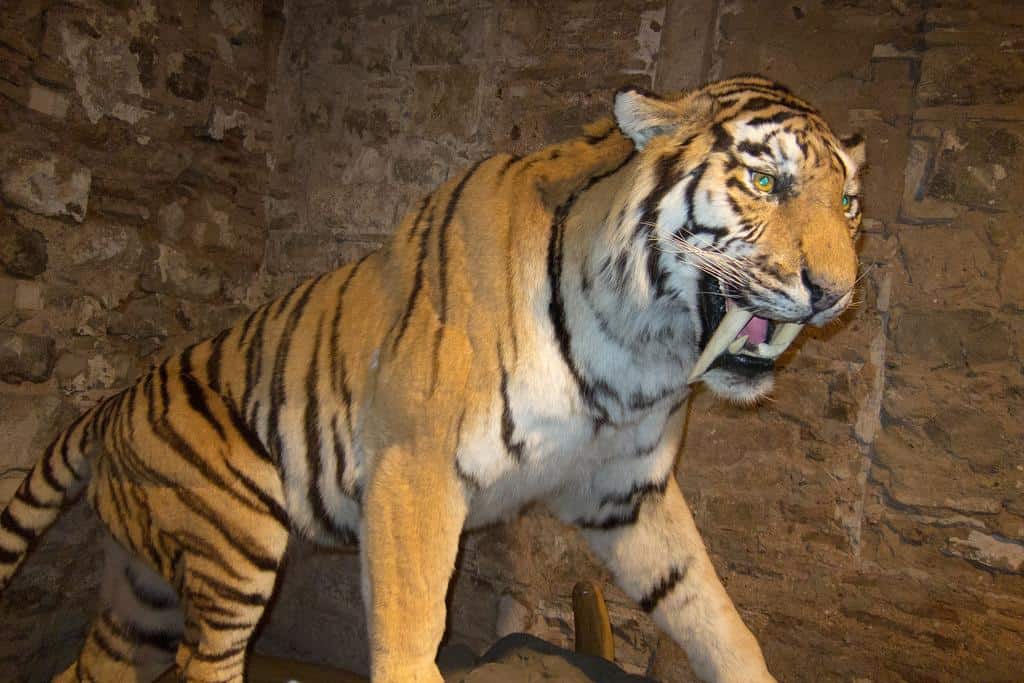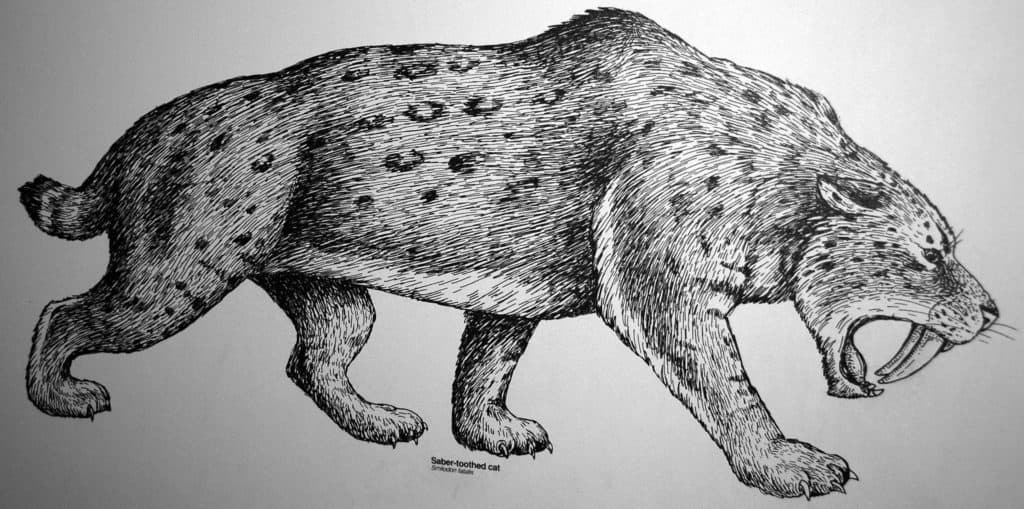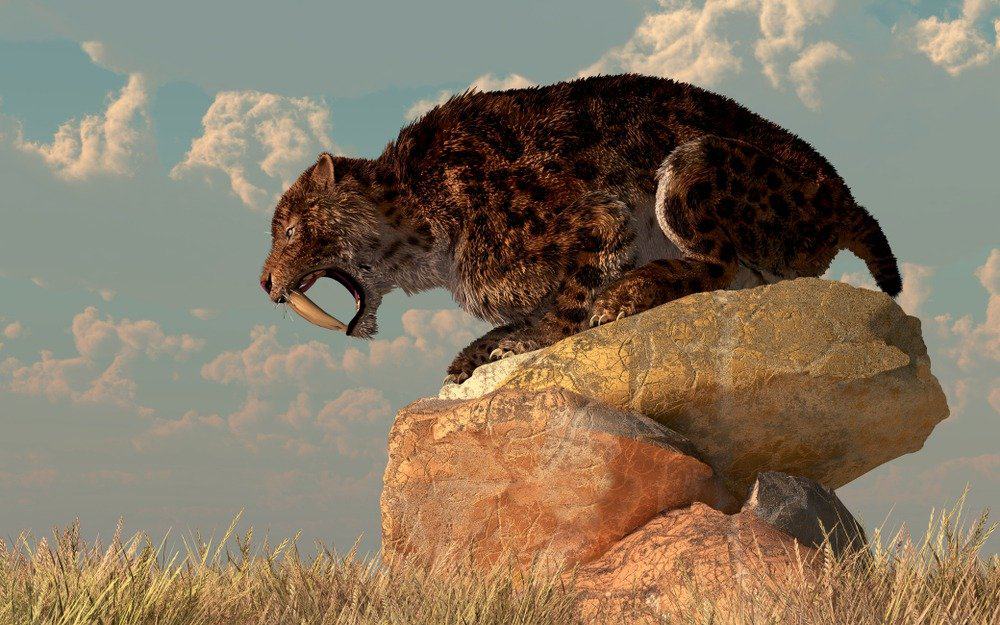Key Points:
- Sabertooth tigers became extinct when the Ice Age ended during the Quaternary extinction.
- Sabertooth tigers went extinct because of climate change and over-hunting from humans living during that time.
- These prehistoric cats ate woolly mammoths, mastodons, giant sloths, caribou, elk, oxen, camels, bison, and other big animals.
The sabertooth tiger is an extinct mammal that roamed the land thousands of years ago. There are three types of sabertooth tigers in the Smilodon genus, but all of them are extinct. When did sabertooth tigers go extinct?
While an image of this formidable animal comes into our imagination when its name is mentioned, that doesn’t mean it looked like that. Because we only have fossilized remains, their exact appearance is unknown. They probably came in a variety of colors depending on how they interacted with their environment and when they hunted.
What are some other interesting facts about sabertooth tigers? Why aren’t sabertooth tigers still around? When did sabertooth tigers go extinct? Let’s find out!
When Did Sabertooth Tigers Go Extinct?

Sabre-tooth tigers went extinct around 10,000 to 12,000 years ago
©Thomas Quine / CC BY-SA 2.0, Flickr – License
The sabertooth tiger went extinct about 10,000-12,000 years ago. They became extinct during the Quaternary extinction at the end of the late Pleistocene period when the last Ice Age ended.
Megafauna around the planet disappeared at this time along with the sabertooth tiger. There are various theories about why this happened but no one is certain. We do know that animals don’t just go extinct because they’re done being animals. Something has caused this extinction.
Why Did Sabertooth Tigers Go Extinct?
Sabertooth tigers went extinct because humans overhunted them at the same time that climate change was occurring. They also lost access to easy food in the form of megafauna. We know from the teeth of fossilized sabertooth tigers and megafauna that they hunted in packs to take down these large animals.
There is evidence food shortages weren’t the only contributing factor to extinction. The fossilized remains of some sabertooth tigers were studied and their teeth over time showed no extra wear. This means that the animals didn’t start gnawing off every morsel of meat in desperation toward the end of their existence.
Animals that are desperate for a meal leave behind fossils with more worn teeth than well-fed predecessors. Since no differentiation in wear exists in the sabertooth tiger fossil record, it may be safe to assume that they ate well until the end.
These animals were adapted to cold weather but they reacted very poorly to the rapidly increasing global temperatures at the end of the last Ice Age. It may have only taken 100 years of rising temperatures to wipe sabertooth tigers off of the face of the planet.
What did Sabertooth Tigers Eat?

Animals such as woolly mammoths and mastodons were hunted by sabre-tooth tigers
©Dotted Yeti/Shutterstock.com
Sabertooth tigers were apex predators that ate large mammals. Even huge beasts like the mastodon were considered fair game.
They chowed down on woolly mammoths, mastodons, giant sloths, caribou, elk, oxen, camels, bison, and other big animals. These cats were huge so it took a sizeable amount of meat to keep them going. They weighed up to 750 lbs., were three feet tall, and 5.5 feet long.
When megafauna went extinct, it greatly affected sabertooth tigers and aided in their demise.
Why are they Called Sabertooth Tigers?

The sabre-toothed tiger got its name from its two long canine teeth which could be up to seven inches long
©James St. John / CC BY 2.0, Flickr – License
Sabertooth tigers earned their name because they had two huge canine teeth in their upper jaw. These giant teeth grew up to seven inches long. A sabertooth tiger’s jaw was huge so that it could accommodate them.
These canine teeth gave them the ability to inflict devastatingly precise bites. Combined with their powerful jaw that opened much farther than any modern cat, they were able to crush or mortally wound their prey with one bite.
Where did Sabertooth Tigers Live?
Sabertooth tigers lived near their food in grasslands, forests, and shrublands. Their range covered all of the Americas from the tip of South America through much of North America as well as much of Europe. Their ranges almost always included some kind of permanent water source and plenty of hiding spots.
The first sabertooth tiger fossil was found in Brazil in the early 1800s. Sabertooth tigers are not the only sabertooth cat to go extinct but they’re the most widely distributed. While not all sabertooth cats existed in the sabertooth tiger’s range, many different species of big cats lived in overlapping territories.
Sabertooth Tigers in Los Angeles

Hundreds of thousands of sabertooth tiger fossils were found in the La Brea tarpits in Los Angeles, CA.
©Daniel Eskridge/Shutterstock.com
The La Brea tarpits in Los Angeles, CA played host to hundreds of thousands of fossilized sabertooth tigers. These cats are the second most harvested fossil at this site. They fell into the pits when they tried to hunt animals that were already stuck in the tar.
The sabertooth tigers extracted from the La Brea tarpits in Los Angeles constitute the largest single collection of these cats on earth. A large number of other extinct cats and dire wolves were also recovered.
The word “brea” means tar in Spanish. Early settlers and the indigenous community in the area used the tar for a variety of purposes like roofing. The tar pits were also used as a source of oil.
An early name for the La Brea tarpits was “la huesomenta,” or boneyard. These bones were believed to be that of cattle and modern animals until they were analyzed. People knew that the tar pits contained a lot of bones, but no one knew they were ancient until the 1900s.
Are Sabertooth Tigers Like Modern Cats?

Sabre-toothed tigers are nothing like modern cats today
©Rom-diz, CC BY-SA 3.0, via Wikimedia Commons – License
No, sabertooth tigers are not like modern cats. They are also not related to modern tigers and are most closely related to modern clouded leopards since they share a related skull shape. While they’re big cats, they aren’t a lot like any of the cats still left on earth.
Sabertooth cats hunted in packs as evidenced by their fossils. Broken bones were allowed to heal while the animal was alive. This suggests that groups of cats allowed injured members of their group to feed.
They were around the size of a modern lion but they roared much louder than one. Lions do hunt in packs, and some scientists imagine that the hunting patterns of sabertooth tigers vaguely imitated their behavior. Sabertooth tigers were heavier and shorter than modern lions.
Modern cats are agile and stalk their prey whereas sabertooth tigers were ambush predators that were more stocky. They simply weren’t as adapted for chasing down their meal.
Instead, they struck out at their prey when the timing was right. They used their huge saber teeth to slash their throats or cause other fatal damage. Then they would wait for their victim to bleed out before consuming them.
Saber-Toothed Tiger Reproduction, Babies, and Lifespan
Researchers believe it’s likely that saber-toothed tigers were seasonally polyestrous. Meaning, the female could go into heat more than once during the spring breeding season. Every year, every fertile female would become pregnant by the dominant male she accepted. The males would battle each other for mating rights. The gestation period for a baby saber-toothed tiger was eight months. A typical litter of cubs was three.
A saber-toothed tiger had a lifespan ranging from twenty to forty years if it did not encounter human hunters.
Up Next
The photo featured at the top of this post is © James St. John / CC BY 2.0, Flickr – License / Original
Sources
- Wikipedia, Available here: https://en.wikipedia.org/wiki/Smilodon
- Berkerley, Available here: https://ucmp.berkeley.edu/mammal/carnivora/sabretooth.html#:~:text=It%20went%20extinct%20about%2010%2C000,arthritis%20and%20other%20degenerative%20diseases.
Thank you for reading! Have some feedback for us? Contact the AZ Animals editorial team.






